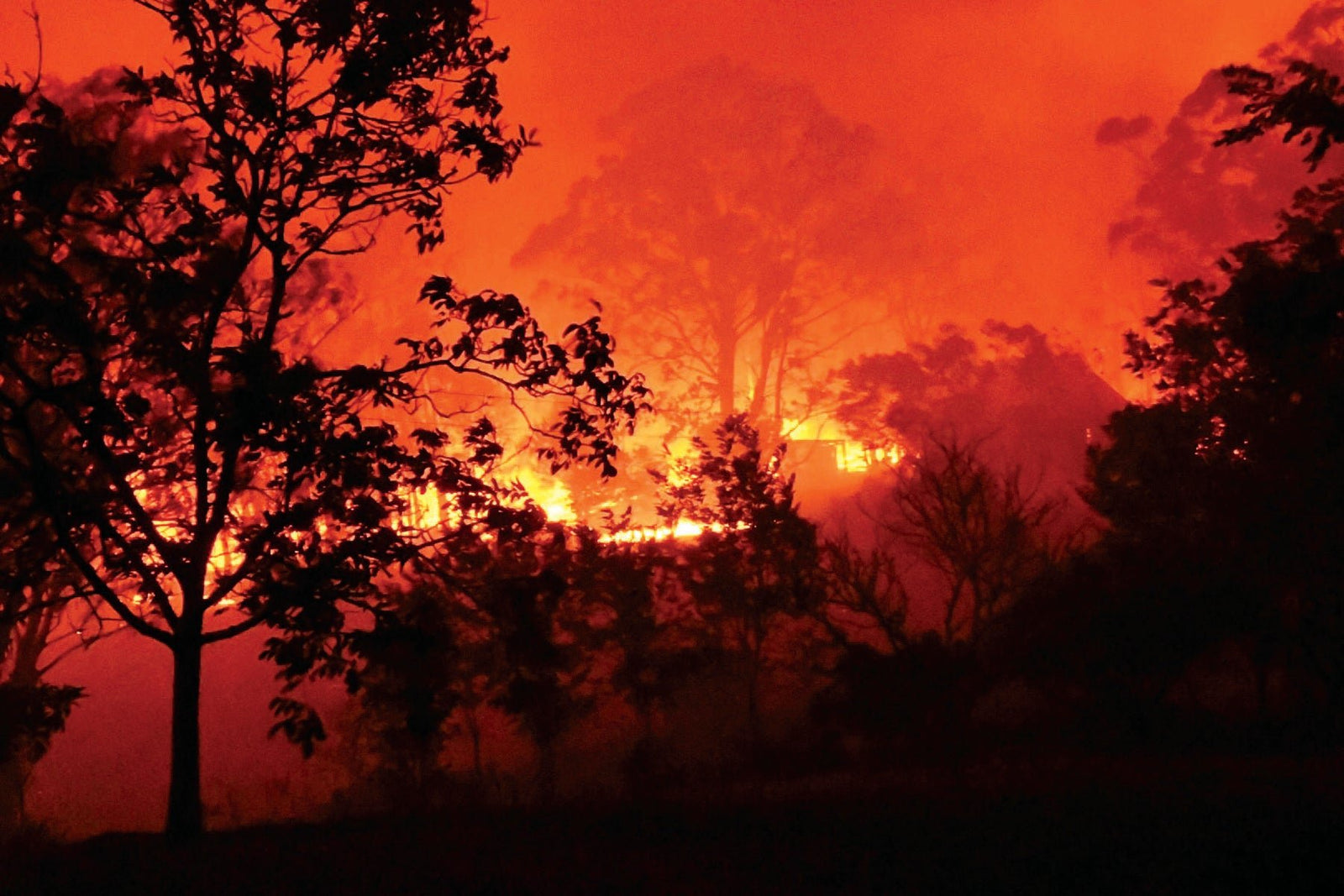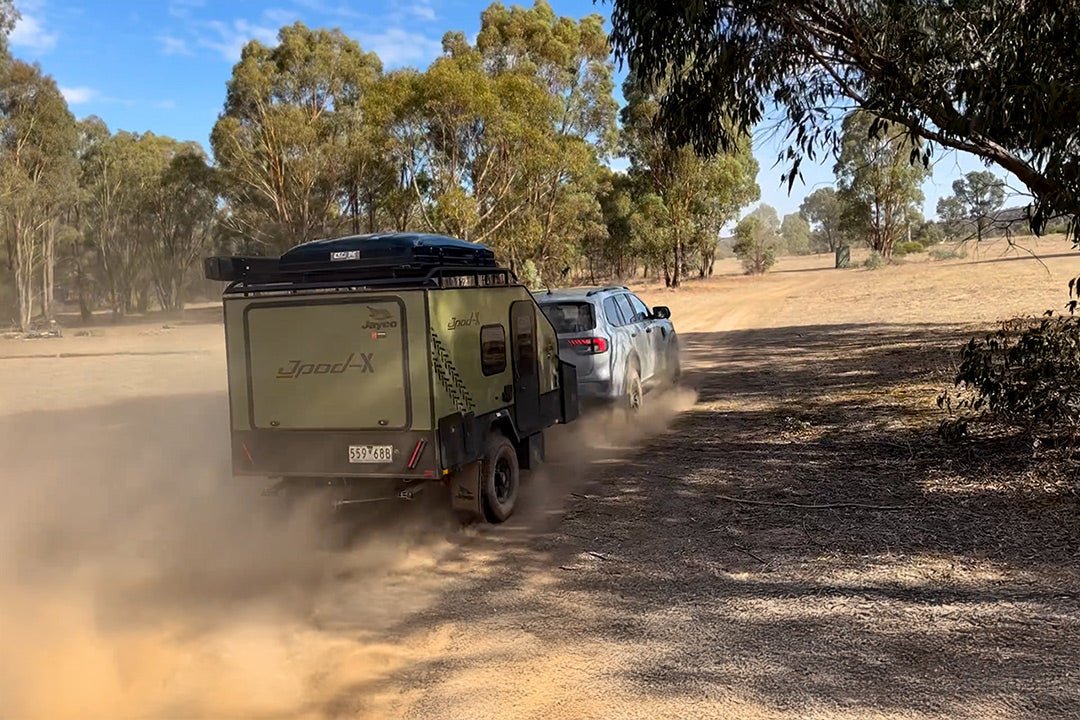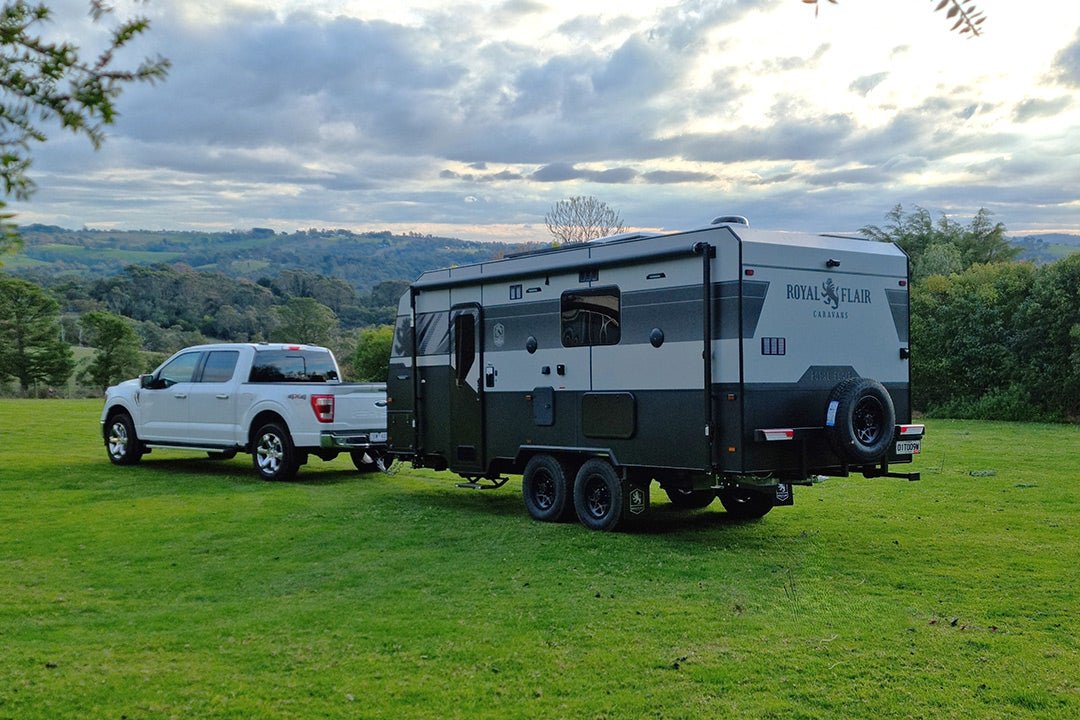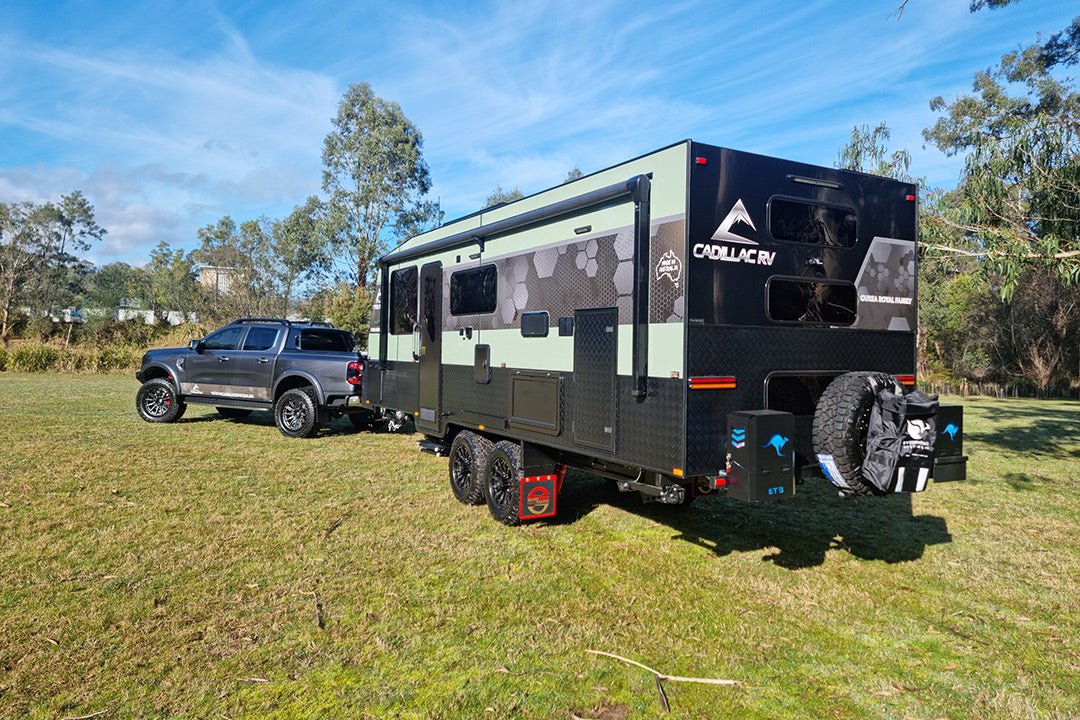The South Coast Fires

It began with a charred but intact eucalyptus leaf on our front doormat. It was not an ash vestige of a leaf, but had weight and substance and had wafted under 4 metres of front entrance roof. I contemplated its appearance as some sort of omen as there were fires in the area and the prognosis was bad.
It was the night before New Year’s Eve, the penultimate end of the decade, and while Sydney declared its allegiance to the Harbourside fireworks spectacular, we were seriously preparing for a downbeat yet devastatingly dramatic fire show. The ‘Fires Near Me’ app had taken a sterner tone than usual with lines like, “lives will be at risk”, and the BOM forecast winds of 35 – 60km/h.
We had exhausted ourselves with preparations, and our last day focussed on the area around the church, caravan and back shed — lesser assets but a greater risk.
The bush encroaches here and connects to extensive forestry lands. We scraped the land outside the fenced area clean of leaf litter with the bucket of the tractor, rake hoes and similar tools. We had worked till the light was fading around 8.30pm and vowed to resume in the morning.
Later that night, crossing into the first minutes of New Year’s Eve, Marg, myself and Rob (an occupant of the caravan and shed nestled behind the old church on our property) went for a quick reconnaissance, walking to the road and up towards the old church. There was a dim red glow behind the hills in three different directions but, thankfully, not a breath of wind.
Around 2am this stillness gave way to wafts of warm air and my restlessness jumped a notch. I went for another walk around. The red glow had become more menacing and flames were now visible on the ridge line to the north. We had thought we might have one more day to prepare, but it was becoming clear that wouldn’t be the case.
I headed to the church to get all the music gear to stow in an effectively airtight shipping container. We considered this the safest place on the block and had put our important documents, photographs and treasures here. All the while the winds were strengthening. Night winds are unusual in our protected valley so niggling trepidation started to set in.
Our strategy for the fire, apart from outside prep, involved all the usual stuff — seal cracks, ditch the curtains, move furniture away from windows, have buckets of water throughout the house, full water tanks etc. We had also created a useful, mobile firefighting asset by purchasing a twin impeller Honda firefighting pump and along with a 1000 litre UBC plastic tank to stick on the back of an old 4WD farm ute.
We usually had a permanent creek on our property, but it had been reduced to a series of disconnected, turgid pools. We needed to be careful with its usage, but it was to provide an extra reservoir tapped by the 3-inch PTO pump on the tractor. This thing hoofs out a serious volume of water. It had been used a few times to fill tanks around the farm, but we had not tested it at the house paddock before as a more demure, and cheaper to run, 2.3kW electric pump usually handled this.
At 4am it felt like it was time to get the tractor pump setup on the creek. My headtorch guided the lightless tractor down the road and across the paddock through air already swirling with eye stinging ash. Pulling up to waterhole in a situation not offering a lot of manoeuvring room, we found the outlet to the pump was facing opposite to the direction required.
I couldn’t turn the tractor around to have the outlet facing the right way as that would require driving the front of the tractor into the pond over a very steep face or having a suction line that was 4 metres longer than it was. The best we could manage was a 7-point turn to get the tractor 90 degrees around and wrangling some rather inflexible 50mm polypipe 90 degrees around from its usual alignment. Thankfully, starting the tractor, engaging the PTO, priming the pump and shooting some water to test the connections proved successful.
Walking back to the house through smoke laden air and strengthening winds, there was a feeling disaster was rushing toward us.
Assembling the cars in the clearest space on the crown of our small hill meant they were gathered around a power pole about 10 metres away from a large box tree already putting on a display of writhing limbs. As a large branch twisted out of the crown to land hard on the ground, it seemed the 60km/h wind speed was likely underestimated.
Over the ridge to the west we could hear the roar of the beast and see its scarlet glow and billowing smoke. It was hammering down that corridor but presenting a flank of the fire to us and only slowly getting closer. Flames were evident to the south, while to the north large flames leapt off hilltops in the middle distance. There lay our main problem.
Once the tractor was fired up, it was all hands on hoses, wetting down the ground underneath and around the cars and shipping containers (we had only recently realised wooden floors in shipping containers do not have a metal skin on the underside — ours are vulnerable as the sloping site elevates the back) and setting sprinklers around the cars. After wetting down around the house and leaving some strategic sprinklers running, we retreated indoors to await our fate.
The roaring of the fire flank to the west felt merciless as the wind continued to strengthen. All hopes of getting out of this easily were dashed. The air was hot and no amount of fluids quelled a dry mouth of anxiety.
Huge flames flared above the treetops to the northwest, dancing through drafts of volatile vapours. It was like having ringside seats to Cadgee Theatre Company’s staging of Dante’s Inferno.
It was right there in our face but wasn’t seeming to get closer as quickly as I expected.
A spot fire began on the steep hillside to the east and moved slowly downslope toward us, widening as it came. Fire now surrounded us pretty much on all sides. The heat projected through the windows could be felt from a couple of feet back.
Then it was upon us, leaping the last 150 metres in a blink of an eye. Barely scorching the paddock, it jumped up the steep slope from the creek and swirled around us, simultaneously igniting trees, bushes, bamboo clumps and the spa deck. The fibreglass and timber of the spa deck, backed by a particularly volatile species of bamboo, manifested into a nasty hot spot in close proximity to the northeast corner of the house. It made no difference that the spa was full of water as the fire gobbled the treated pine timber decking like an appetiser, had the fibreglass for entrée and settled into the heavy hardwood support structure for a hearty mains, all the while funnelling heat at our ironbark rafters and beams.
Right at this moment we got a call from the local brigade to see how we were going. I was surprised we still had phone and power, but managed a quick reply regarding rafter ignition, which brought a considerate, “Better let you go then.”
The fire outside was still intense, but the embryonic fire in the roof structure needed to be sorted. There was no hose readily accessible, but the front sliding glass door allowed a fairly quick dash. Three quick forays, with buckets of water hurled vaguely upward, were all I could manage before I was to the point of near collapse. The heat, the horrid thick smoke and fumes from burning fibreglass, plastics and electrics coming up the same swirling vortex that caused the rafter ignition was, at the very least, a flagrant crossing of any OH&S manifesto.
Hoping enough was done to quell this threat until conditions were more manageable, we scanned the rest of the building. It was far less threatened, and the sunken back entrance on the southern side of the house was like a cool bunker by comparison with the spa-ferno.
We could see our old historic church in complete combustion, it’s flaming shape accentuated by lines revealing its stud and steeply pitched rafter timbers. Collapse was imminent and still conditions outside were far too intense to engage with.
We had held optimistic notions of being able to save our building assets, large and small, with our preparations and fire fighting resources, and perhaps in a more benign fire may have achieved this. The church was the only building visible to us, so we wondered how everything else was doing.
I am not sure how many more minutes passed before we tentatively left via the front door to see if conditions outside had improved. It was unpleasant, but exposure was sustainable with our basic paper face masks — we had forgotten to get enclosed eye protection from the shed in the chaos.
First thing to check was the cars. Having watched all his other possession go up in smoke, Rob was desperate for his car to be ok. The three assembled cars were intact, save some melting peripheral plastics, and they were quickly hosed down from the mobile pump while scanning for the next priority.
Alarmingly, the large metal shed with so much equipment and a lifetime of gathered tools was ablaze inside. It seems the translucent alsinite roof sheeting was the weak point in what I thought a fairly fire safe structure as embers were able burned through. With no ready way to get to the bed of the flames devouring the shed I had to shrug off its demise.
The next thing to catch my focus was the stack of chunky 10 by 5 bridge timbers that were not yet consumed. A hefty wet blast their way elicited a substantial hiss but only a brief hiccup in the process of combustion.
Using the 2-inch quick fill line connected to our main water lines and a supply from the tractor PTO pump dutifully rumbling away in the creek, we started to top up the tank, but then lost our water. This was definitely unwelcome, but not unexpected. I knew the poly plastic standpipes that dotted our yard for normal watering duties were vulnerable, but there was the thought that they could endure a fair bit of flame if full of water. It turned out later it was a combination of heat softened plastic and the high pressure in the lines that blew off the head of a multiple outlet standpipe near the bottom of our hill that denied us water (the next day I found it and it screwed straight back on, thread undamaged).
With the remaining water in the pump setup, I attacked a clump of bamboo threatening to ignite the eaves, but the tightness of the clump made it difficult. Soon the portable tank was empty, the garden hoses commanded by Marg and Rob had dwindled to an insipid trickle and the job was far from done. Fire raged all around so we took to the buckets, an old fashioned but still effective, albeit physically demanding, method.
Hell came to Earth on this endless night. Some say the sun did come up, but the fire held sway on the last day of 2019 and at best, the brightness was no lighter than the last vestiges of twilight on a moonless night. It was a remarkable thing. I don’t know how high this layer of smoke went to completely snuff out the sun, but at ground level it was thick enough to catch in your throat and make your head pound.
We quickly depleted strategically located buckets around the house and then robbed the nearby garden ponds of their weedy wetness. When they were to low to harvest, we walked down the hill to plunder the grandchildren’s swimming pool.
Exhaustion was now as much an enemy as fire. We took turns to lie on the floor in the house with a wet towel across our faces to filter a little more filth from the air and relieve the burning in our lungs — I don’t know what was worse, the shredded lungs or the burning eyes.
It takes a lot of bucketed water to put out burning trees and stumps supporting shipping containers. We kept at it till it was done, exhaustion be damned. Rob, the temporary tenant, worked beside us the whole time. I honestly don’t know if we would have saved the house without him. We can’t thank you enough Rob for your massive effort.
Satisfied we had diffused any lingering or close fires after many hours in the complete darkness of mid-afternoon, we laid our spent bodies down on the floor seeking rest and perhaps better air. We had no light, electricity, phone, radio or way out to the normal world. It was over and all we could do was wait, for the light, for the new year and for news of others.
After a time the sound of trees capitulating in their battle with lingering flames was augmented by the chainsaws of the local brigade clearing roads to check on the welfare of community members and reconnect with the world at large. The red and blue flashing lights eventually made it up our driveway.
Soon other vehicles called in to see how we’d fared, and that fuzzy unnamed feeing of an ordeal shared began to weave its nurturing healing magic and seeds of recovery.
The losses are large and tragic. We lost the church, the cottage further down the farm, all our sheds and everything inside. A lot of stuff in the shipping container melted including both my music keyboards. The thing that almost brought me undone was the melted shape of the Alesis Nitro Electronic drum kit I had just bought for my grandson, Alec.
I don’t know what will recover in the gardens we have spent four decades nurturing, but we still have our house. Many we know have lost so much more. Some have lost everything, even their lives. I feel such devastation for those walking away with nothing.
But, amongst the sadness and sense of loss, you can detect a hint of hope and a shared something that bolsters the soul.
Reflections may take time and I could have done many things better, but many lessons have been or could be learnt. They have been dearly paid for, so we won't waste them.







